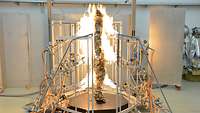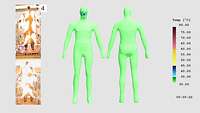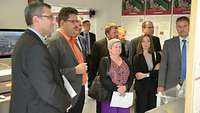Protective performance put to the test: when does a uniform catch fire?
Protective performance put to the test: when does a uniform catch fire?
- Date:
- Place:
- Munster
- Reading time:
- 2 MIN
During operations, our troops are exposed to many dangers, including fires. So naturally, their clothing systems have to endure a lot. A team of the Bundeswehr Research Institute for Protective Technologies and CBRNchemical, biological, radiological, nuclear Protection (WISWehrwissenschaftliches Institut für Schutztechnologien - ABC-Schutz) in Munster, lower Saxony, performs tests to find out at what temperatures things get critical.
In the field of fire safety engineering, WISWehrwissenschaftliches Institut für Schutztechnologien - ABC-Schutz participates in a research cooperation with France. During a visit by a Franco-German delegation, this collaboration was further intensified.
Two test approaches – one goal
At WISWehrwissenschaftliches Institut für Schutztechnologien - ABC-Schutz, the guests had the chance to visit, among other things, the test stand designed to simulate the effect of darting flames. This is where different items of clothing and equipment are tested for their resistance to heat effects caused by flames. The temperatures measured on a special dummy are then used to determine the corresponding degrees of burn with the help of a calculation model.
The studies show that, put simply, no burns occur as long as the skin temperature is below 44 degrees Celsius.
In Toulouse, France, a similar test stand for clothing systems is in operation. The test stands of the two countries, however, differ in the type of flame exposure and other aspects, including the measurement technology. Only the dimensions of the dummy a nearly identical.
To be able to compare the test stands, three German and three French sets of clothing were examined on both test stands. The test stands’ technical data and the test results could then be exchanged and analyzed.
The goal of the research cooperation is to make the results of the different test stands comparable and thus further develop the respective test methods.
Test stands produce similar results
Both test stands lead to similar assessments of the clothing systems’ performance. However, due to differences in the flame direction, the test data is not yet interchangeable.
WISWehrwissenschaftliches Institut für Schutztechnologien - ABC-Schutz will take into account the findings obtained for the further development of the test stand.
Helpful findings also in other fields
In the field of “Nuclear weapons effects and ionizing radiation”, the guests also had the opportunity to visit the free-field thermal radiation simulator. On this test stand, the impact of intense heat on different materials such as window frames or window glass is examined. An aerosol made of aluminum powder and liquid oxygen is used to create extreme heat. The insights gained on this occasion will equally contribute to future Franco-German projects concerning defense technology.





